Constructing Cultural Identification in Digital Chinese Opera
DU Yihang, CHI Xuefeng
Abstract:
Chinese opera is a comprehensive art form that integrates singing, dancing, poetry, and music. Virtual reality (VR), augmented reality (AR), and interactive installations provide new platforms for opera creation. The performance formula, the voice quality, and the physical parameters of music are all key factors in constructing the cultural recognition of opera. Digital media forms basic ideographic units based on the overlapping, juxtaposition, appropriation, and mixing of images, constituting narrative or non-narrative grammatical paradigms, and rewriting the intertextual reference and non-aesthetic conception of traditional audiovisual texts. Based on media archaeology, the representational schema of digital opera shall be established; the research on the interactive vocabulary of digital opera through scene interaction shall be conducted; the interaction among roles and viewpoints shall be applied in spatial modeling; the research based on modeling language of digital opera research shall be composed into the modeling of space, character, and sound. As a result, a theoretical system of digital opera from ontology to methodology shall be formed. This research will help the audience to understand the nature of virtual reality, interactive video, and digital performance systems; it will also help to establish a methodology for the creation of digital opera. It provides a bridge between theory and application for the creative transformation and innovative development of Chinese traditional culture in the digital age.
Keywords: the art of digital opera, digital media, ideographic patterns, interactive vocabulary, modeling language
Opera is an artistic complex that integrates various elements such as performance, script, character, singing, costume, and makeup design. Its stylized performances, Eastern aesthetic characteristics, and stage performance techniques have formed a widely recognized symbolic language system among the public audience. Through the expansion and sublimation of social life, it builds an aesthetic conception with oriental cultural recognition at the material and spiritual levels[1]. After the continuous enrichment and innovation of the performing artists, the opera has been endowed with a strong vitality of the times.
Digital media mainly relies on technical support such as virtual images and interactive devices, and it has gradually developed into various new media forms such as mixed reality, augmented reality, space augmented reality, and physical mixed reality. Digital media creates surreal interactive spaces for audiences through new display and human-computer interaction technologies. It is widely used in cultural communication media such as large-scale cultural performances, interactive images, and urban space media[2]. Digital media subverts traditional expression techniques, such as composition which starts with a two-dimensional plane frame, scene differentiation, and montage; instead, it creates a surreal sense of immersion for users through visual, auditory, tactile, and other multi-sensory information. The audience can autonomously connect and capture multi-modal information through the control of sight, sound, and action to complete dynamic scene construction[3]. The expression of opera art in digital media manifests the aesthetic psychological structure of the audience and the social inevitability of forming this structure. The non-limited expression of audio-visual forms such as singing, reading, writing, and playing must comply with the identification construction rules of Chinese traditional culture, and restore the identity of the cultural matrix in the digital age.
The mimetic and symbolic performance of opera is constrained by the performers' physical ability and techniques. The performers' physical energy, athletic qualities, and close-body spatial perception, among other biological characteristics, support the aesthetic transformation of their techniques. Precise comprehension of the balance between form and beauty is the foundation for constructing a culturally recognizable and symbolic language system in digital media. This research attempts to explore the expression methods of opera procedural performance in computer-generated virtual systems, to establish a culturally recognizable digital media corpus, and to explore the remedial rhetoric of traditional art. This research will also help to provide a theoretical and technical foundation for the rehearsal, performance, and development of an immersive opera teaching system.
1. The Expressive Pattern in Digital Opera
The key to constructing cultural recognition in digital opera lies in proving the potential role of expressive pattern. The expressive pattern studies the ontology of digital media; it opens a philosophical discussion that combines media with language, culture, and subject state; it also explores the metaphysics of media research. Digital media such as virtual reality and augmented reality have subverted the transmission method in traditional media. In cyberspace, audiences can independently perform dynamic reconstruction of audiovisual language and multimodal information by controlling the sight, sound, and action. It provides a multi-sensory, cross-channel system for opera performance, and completes the dynamic configuration of a surreal experience in media interaction[4]. The interactive transmission of audio-visual information has greatly enriched the expressive tension in opera such as body performance, stage space, and panel voice in new media, breaking through the limitations of traditional theater with the ideographic form of hyperlinks, and calling on the audience's active imagination to cooperate.
The mindset and operational logic, the storage, recall, and update of images correlate together to form the rhetorical attributes, formal language, and cultural concepts in digital media, which significantly deviates from traditional media with a high degree of interactivity and openness (as shown in Figure 1)[5]. The narrative story in a flexible time and space is the source of the digital opera. The transmission, interaction, and navigation of information in the digital interface, as well as the degree of psychological participation of the audience, are all required to follow the expression law in opera, to build the delivery channels inside and outside the digital text, and to form the aesthetic transformation of virtuality and impressionist-style brushwork.
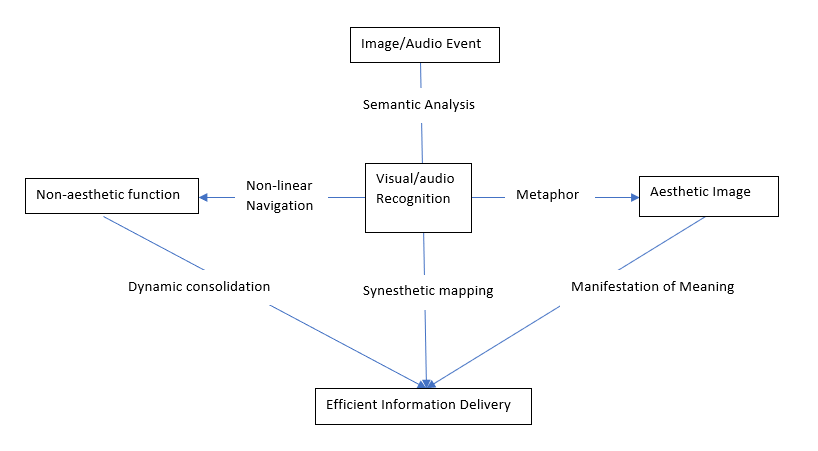
Opera has deep roots in ancient civilization. From primitive drama and primary drama, it has gradually developed to an agglomeration of traditional Chinese culture; from a mimetic and symbolic behavior; into a stage art with fixed formulas, clear lines, and complete structure; into a cultural form with oriental aesthetic characteristics. Media is the medium of information transmission — from bone, shells, and paper to digital and virtualized audio-visual systems, visual art has gone through three stages of imitation, reproduction, and generation, and has formed a connection with the change of the art form of opera in “l'archéologie du savoir” (a term originally coined by Michel Foucault. It is borrowed here to indicate that the development of opera art and the development of visual art have a similar historical process). The human-computer interaction interface based on digital and information-based software and hardware systems is an ideographic medium. The audience participates in the flow of information through data input and system feedback behaviors. Generative patterns are reconstructed by the words and actions of the audience. Digital media can help to achieve montage strategies such as migration, editing, collage, and stacking in digital opera, and expand the linear process of the traditional opera stage to a non-linear digital time and space. Graphical, three-dimensional, and dynamic media have gradually enriched the reproduction system of artistic texts, enabling the audience to gain a comprehensive experience in aesthetics, learning, and entertainment. Digital media generates hyperlinks, hypertext, and interactive technical carriers for opera art, and also provides aesthetic materials for the digital expression of opera.
Digital media is born out of cinema art, which has used images to complete its narrative function since its birth. Compared with images, sound is absent due to the common limitations of historical context and material technology. It was not until the "silent mute began to speak" that the audience was freed from the silence, and that sound began to be used as an auxiliary symbol
to give meaning to the media's audio-visual aesthetics, therefore the primitive form of information representative of the primitive people was restored. (Movies used to be silent; after the birth of sound movies, sound became an aid in the narrative of movies and started to possess an aesthetic meaning. Starting from then, vision and hearing as the two natural attributes of human perception of the world, are finally restored.) The sound sequence in the virtual reality media interaction task assigns the mapping relationship between the symbol and the object and reshapes the aesthetic image of the auditory text after transcending the conventional law of similarity. As an extension of the body of the live person, sound is brought into the media field, and it participates in the communication between the two worlds as the representative of the audience. It is isomorphic and heterogeneous with the image, and the soundscape is annotated in the representation of digital media.
The complex spatiotemporal structure of tuber cross-linking and dynamic interlacing within digital media enables the audience to obtain a continuous increase in the degree of participation in the interactive experience. Opera is an art of audio-visual integration. In digital media such as virtual reality, audience participation depends on the level of individual attention. Audio-visual selective attention behavior is the result of the coupling of two factors: Bottom-up (BU) and Top-down (TD). Deep engagement and close attention work together to complete the construction of immersion in digital media. Vision and hearing are independent yet interactive senses in the human perceptual system. The information transmitted from the auditory channel in traditional images is often used as compensation for the input of visual signals, while digital media can independently rely on the auditory channel to establish the stereoscopic imagination in space and time for the audience. The maximum likelihood enables the audience to actively capture the ideographic information of the audiovisual integration. Relying on cognitive mechanisms such as navigation scenarios, attention regulation, and signal processing, digital media establishes spatiotemporal rules for multi-dimensional audio-visual integration and creates a highly engaging experience for audiences.
2. Interactive Vocabulary in Digital Opera
The technical structure of digital media (speed threshold, field range, temporal freedom, and sensor sensitivity) provides the possibility of interactive communication for multiple interactions inside and outside the text of opera. Body schemas expand and interpret interrelated cultural information through human-machine interfaces that act as communication mediators. Multiple mapping relationships are created based on the dialogue mechanism of intelligent interactive elements, especially in the field-driven adaptive experience module, the characteristic parameters of the audience reflect the degree of freedom and dominance of the system. The implicit montage, under control of the audience's intention and ideology, stitches the pixelated audiovisual material. The interaction among scenes, characters, and viewpoints creates a freehand opera aesthetic in an immersive, interactive environment.
The interaction of scenes relies on multiple pre-set navigable inner spaces. Through indexing, the audience traverses the visualized information interface. When the physical space of the narrative coincides with the real world, the traditional visual medium will no longer be bounded by the two-dimensional scene frame. The audience's field of view as well as the boundaries of the scene are both extended hierarchically in the multi-dimensional space, awakening the connection between the virtual and the physical space. (In virtual reality, the author presets multiple spaces that can be connected to each other. All interfaces are visualized so that the audience can hyperlink to the next space through the current interface, which can bring users the illusion of entering the real physical space. Compared with traditional movies, the boundary of the two-dimensional interface is broken in VR.) The spatial structure of the virtual opera museum (Figure 2, GAO Yuting, 2022) is based on the shape image of the Chinese character "曲" from the emblem of the Chinese Opera Academy. The head-mounted display (HMD) provides multi-sensory perceptions, such as visual sense, auditory sense, and tactile sense, which participate in information transmission and break through the constraints of space, content, and visiting methods of traditional exhibition. From sympathetic witchcraft, primitive Nuo Ceremonies, and Qin and Han operas to the mature forms of opera in the Ming and Qing Dynasties, as well as the display of the digitally restored cultural relics, the objects acquire life values in a panoramic interactive browsing. The digital exhibits start to have life value and are browsed in the above-mentioned digital space, allowing the audience to experience the development of opera in an immersive way. For opera performances that are not suitable for static exhibitions, interactive roaming can be searched through the attention mechanism, and 3D eye movement data can be collected for real-time adaptive presentation of exhibition content. Compared to the pre-designed plot in a movie,
the image in VR is subjectively selected by the user.
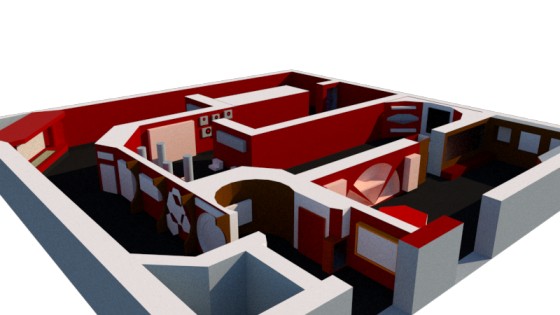
Character interaction achieves information sharing between the audience and images in the form of holistic interaction. The audience joins in the closed-loop scene of gamification as a participant. An example can be used here to illustrate this interaction: in a tourist town, the kunqu Opera interactive experience is embedded in a physical building complex (as shown in Figure 3, LI Qi, 2020); the setting extracts elements from the play The Peony Pavilion for an immersive and interactive experience. It also establishes a functional area of dance experience based on characters’ movements. The Flower God adds a romantic touch to the first encounter between DU Li-niang and LIU Meng-mei in the "Awakening from Dream" symbolizing youth, enthusiasm, and exuberant vitality[6]. It borrows many elements from the youth version of The Peony Pavilion (BAI Xianyong, 2004), such as the costume, makeup, action, and posture of the twelve flower gods, following the same aesthetic principles such as twisting, tilting, rounding, and bending, extracting dancing techniques such as punching, leaning, containing, thrusting, and rising in order to form a pre-made image material library. The large interactive display screen equipped with the interactive device can sense the audience's momentum and use key body parts of the virtual flower god as the interactive variables. The participants’ gestures and postures match the body movements of the characters in the pre-made material library and control the periodic expression of the directional movement of the figure of the Flower God in the ink painting style. This immersive experience dilutes the narrative component of kunqu Opera and forms a pure visual art form.
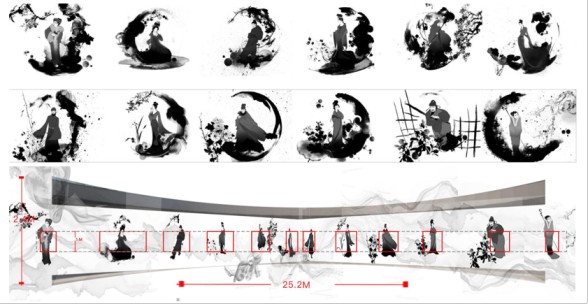
Viewpoint interaction is the proprietary syntax of image assembly in virtual reality. The manipulation of the main viewpoint closely combines the movement and change of space; in the dynamic space and time of the panoramic domain, the narrative trajectory is displayed in an immersive way. The animate design of Ice Play (as shown in Figure 4, original work: ZHANG Weibang, YAO Wenhan (Qing Dynasty), digitalized by BAI Chenzong, XU Hui, 2020) continues the spatial visual characteristics of the original painting, which is known for its academia style and meticulosity. The screen is designed according to the geographical traits of Taiye Pond and is naturally divided by landmark buildings. The dynamic scene provided by the virtual system is able to input, code, store, and extract information from the audience, as well as follow the behavioral logic of the audience. The virtual system is able to form an attention loop in the cognitive nucleus and to achieve the calibration of the degree of immersion in the dynamic interactive experience. The linear narrative logic gives way to the audience's flow experience, the index of material reality in traditional images is muted, and the rhetoric of viewpoint scheduling achieves the nonlinear representation of digital media.
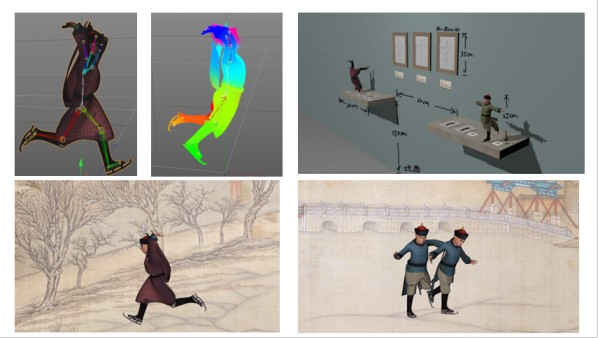
3. The Opera Modeling Language in Digital Media
Modeling, as a non-semantic factor, carries the ideographic function of opera digital art. It participates in, assists, and even dominates narration in the digital medium, which is the twin form of opera performance. The modeling of space, character, and sound are important components of the media narrative language, and the modeling concept of "moving without changing shape" is the norm of the cultural recognizability of opera in digital media.
The modeling relationship, such as light/shadow relation, perspective angle, and depth of field, is an important way to combine computer-generated images with the real world. The spatial design ideas of traditional operas or theatrical sets are still applicable in current times. The virtual stage (Figure 5, DU Siyuan, 2019) is based on the shape and structure of the Wannian Stage in the traditional ancient stage. It combines the mechanization of Cyber-Punk with the aesthetic style of high-contrast neon lights. Cornices,
caisson wells with the function of energy storage, and mechanized performances embody intensively the dependence and assistance of spatial modeling on ideology.
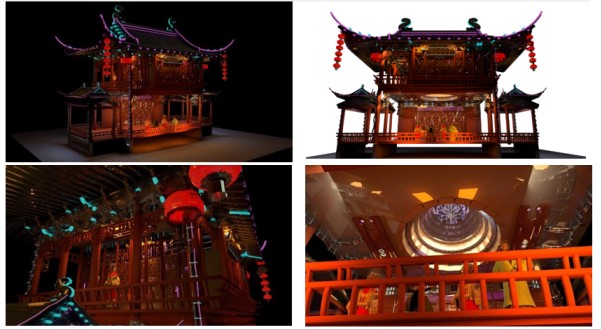
The audience enters the ideographic space through the interaction mechanism, and perceives the ideographic space with internality and personalization through the replacement of the body. Huashan combines the performance elements of the demure female role (qingyi), the coquettish female role (huadan), and the female martial role (daomadan). It is a performance that combines singing, narrating, acting, and acrobatics. The virtual huashan in the interactive performance media (as shown in Figure 6, DU Siyuan, 2022) is based on the image of Concubine Yu performed by Mei Lanfang in Farewell My Concubine. The sword dance elements in Farewell My Concubine are broken, split, and reorganized, and the movement of five key nodes in the audience's body is captured through the motion device to drive the particle-like image of Concubine Yu's figure. The body expression integrated with Confucian aesthetics matches the musical rhythm of Deep Night and the spectacle and pleasure are felt in the active "body experience" and the self-expression of the characters carries the digital image metaphor in the transition from the edge to the center.
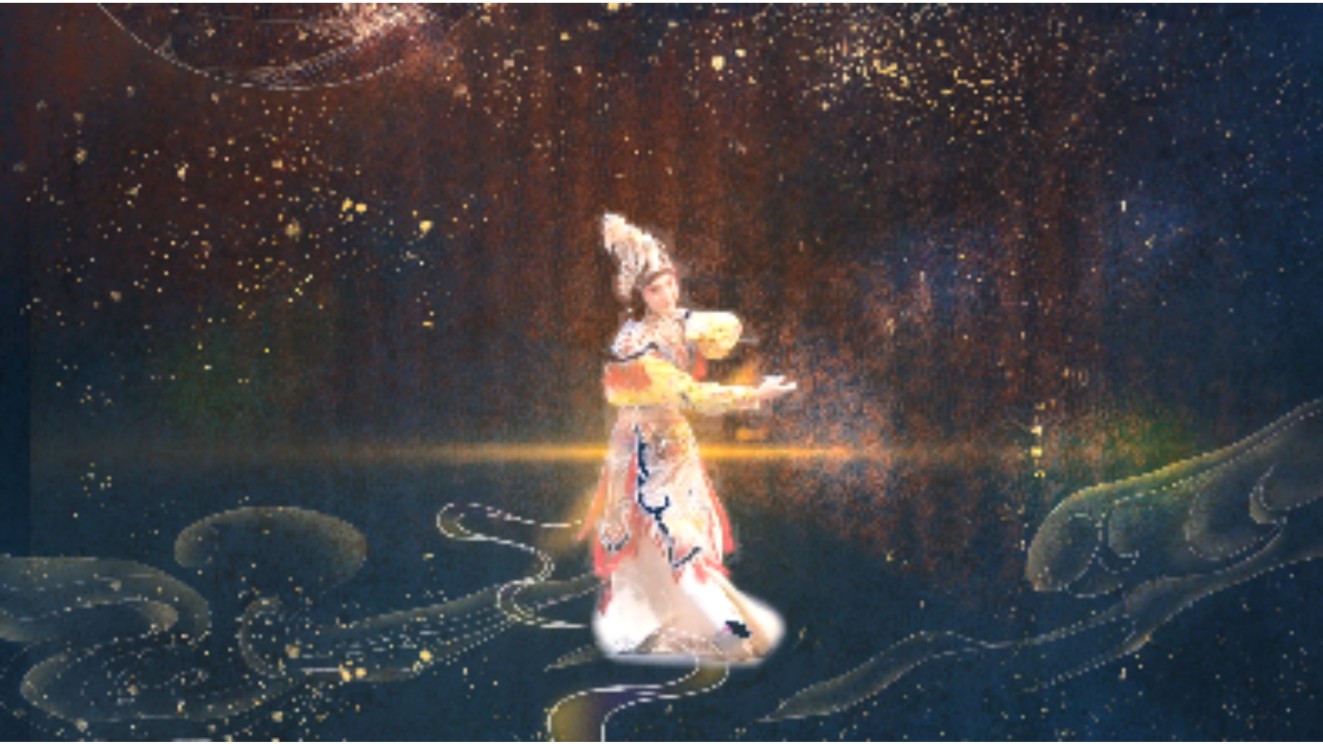 |
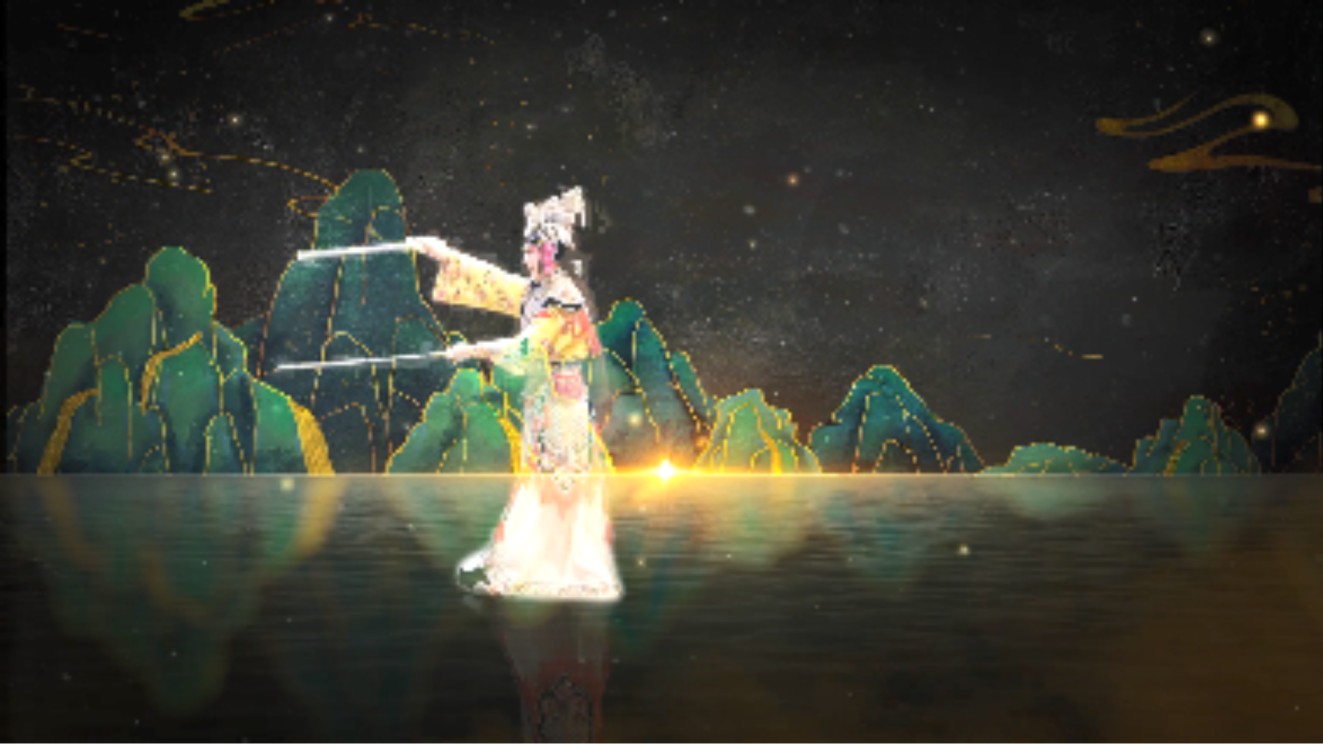 |
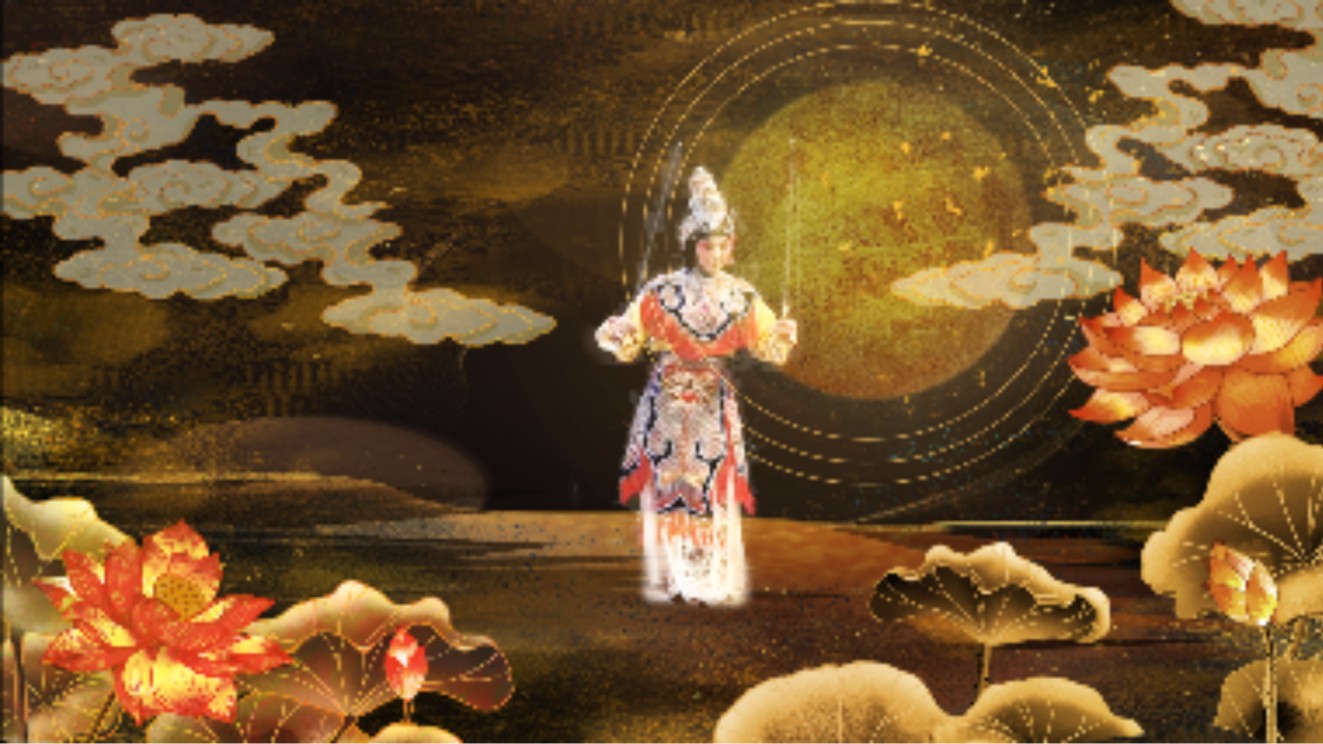 |
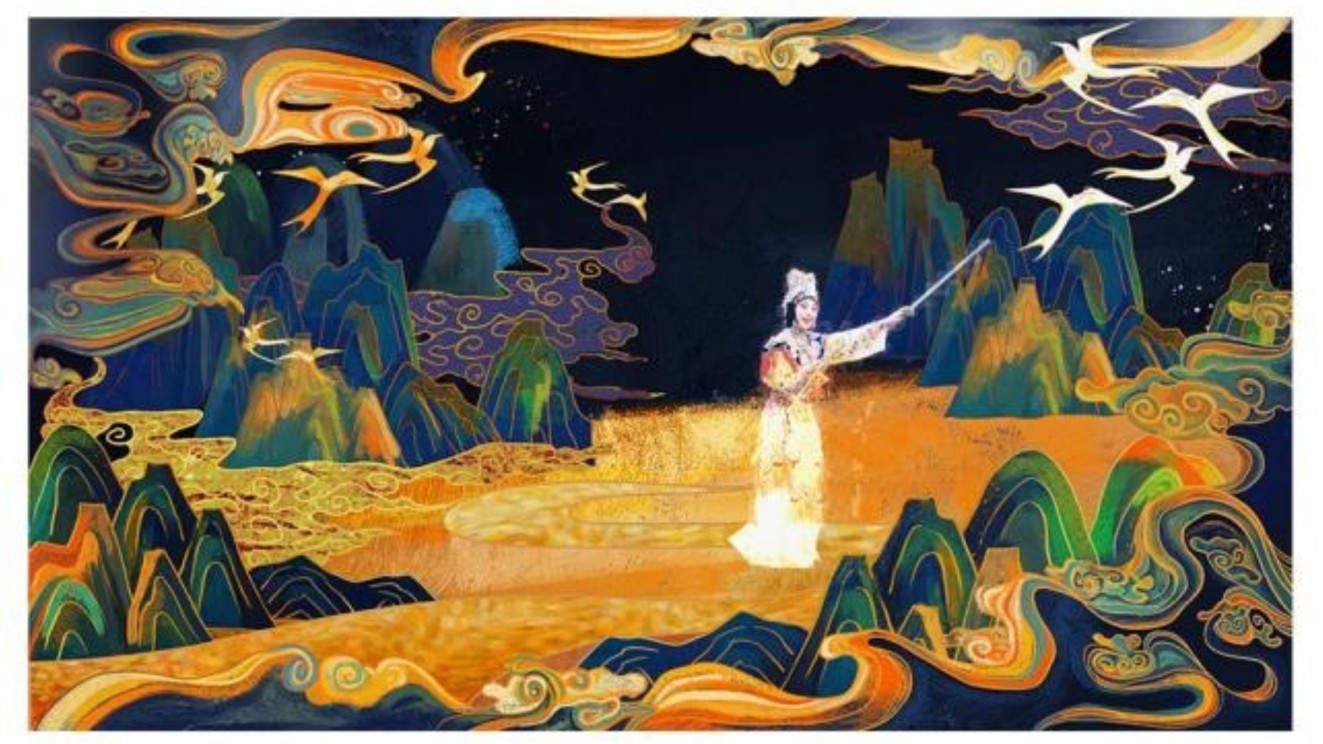 |
Figure 6: Interactive Performance of Virtual huashan. Performer: SHI Yihong. Illustrator: DU Siyuan. Not for download.
4. Conclusion
The research on digital art creation and cultural identity construction of opera incorporates an ontological problem and two sets of methodological problems, combining the theoretical foundations of communication, design, drama and film, psychology, and computer science. Starting from the representational paradigm, interactive vocabulary, and modeling language, this research establishes a discourse system of digital art with interdisciplinary characteristics from a theoretical and practical angle and uses case studies to support and verify the proposed theoretical viewpoints.
From the perspective of technological philosophy and audio-visual culture theory, this research defines the position of digital media in the process of technology history, art history, and media history. This research attempts to understand the universality of digital media as an art form and rhetorical method, and then contributes to the construction of the cultural identity of digital opera.
Digital media breaks through the traditional binary relationship between subject and object and the author-oriented linear narrative method, and participates in the narrative through the immersive experience of the whole sense in the preset time and space, and establishes the subjective position of the audience while gaining the right to speak in the narrative. The digital media goes beyond the flat visual frame and extends to the multi-dimensional space scene starting from the "mass point" which forms a modeling rhetorical method based on scene narrative. Based on case studies and comparative analysis, the interactive vocabulary of digital opera is summarized to provide a theoretical basis for the design of interactive elements in creative practice.
Therefore, the proposed ontology of digital art creation of opera enriches the understanding of the nature of virtual reality, interactive video installation, and digital performance systems. The constructed interactive vocabulary of digital opera is conducive to establishing the methodology of digital media in interactive creation. The constructed language system in digital opera modeling is conducive to establishing a methodology for modeling design in digital media; to laying a theoretical foundation for the new media theory in the digital age; and to building the cultural identification for digital opera.
References:
[1] An, Kui. “On the Construction of the Discourse System of Opera Theory. ” Ethnic Art Research, 2022, 35(01): 140-147.
[2] Manovich, L. The Language of New Media. Cambridge, Massachusetts, London, England, The MIT Press, 2001.
[3] Li, Xun. “Database Movies: Theory and Practice.” Journal of Beijing Film Academy, 2017(01): 50-56.
[4] Li Yang. "From Image Deprivation to 'Brainless Eyes': Dragonfly Eyes in the History of Image Appropriation." Contemporary Films, 2019, 277(04): 137-142.
[5] Rafaeli, S. “Interactivity: From new media to communication.” Advancing Communication Science: Merging Mass and Interpersonal Processes. Newbury Park, CA: Sage, 1988: 110-134.
[6] Yao, Xiaoou and Yang Li. “A Study of the ‘Twelve Flower Gods in The Peony Pavilion.” Cultural Heritage, 2011(04): 17-25,157.
This article is published at TheaComm in Chinese for the first time.
Translator: Yichen Zhang